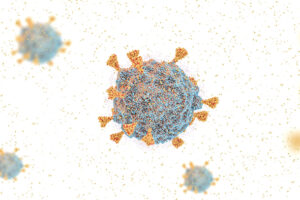Infectious Diseases
Influenza
Antiviral Medications for Influenza and COVID-19
There are several options for the medical management of influenza, with the latest being the cap-dependent endonuclease inhibitor baloxavir marboxil. Antiviral therapies for COVID-19 are also available, but challenges remain regarding their safety and effectiveness. Knowing who and how to treat is becoming more challenging given the many available options, but the appropriate use of these therapies can lead to better outcomes in patients with influenza or COVID-19.
I am in favor of using antiviral therapy because scientific data have demonstrated that the timely initiation of treatment in the appropriate patient, usually within the first 36 to 48 hours of symptom onset, can reduce the duration and severity of influenza and COVID-19 symptoms, while also reducing the risk of complications and secondary infections. Antiviral therapy may even reduce viral transmission because treatment can decrease the amount of viral shedding.
At least 2 types of influenza viruses circulate every season: influenza A and B. The most common antivirals used for influenza are the neuraminidase inhibitors, and these are active against both influenza A and B. Neuraminidase inhibitors are available in a variety of formulations for both children and adults, including oral, inhaled, and intravenous formulations. They should be used in anyone who is hospitalized, has underlying medical conditions, or has progressing disease that is getting worse rather than better, regardless of the presence of underlying conditions. Patients with any high-risk condition should start treatment early, even if not in the hospital; hospitalized patients can start treatment at any time, even if several days have passed since the onset of symptoms.
The newest oral influenza antiviral therapy, baloxavir marboxil, was approved by the US Food and Drug Administration (FDA) shortly before the onset of the COVID-19 pandemic. This agent is a single-dose, cap-dependent endonuclease inhibitor, FDA approved for individuals 5 years of age and older. A single dose of baloxavir marboxil, given early after symptom onset, is as effective as a 5-day course of either oral or inhaled antivirals. It is used in the outpatient setting, for patients who do not require hospitalization.
With oral antiviral options available for all patients with influenza—even infants—I recommend in my own practice starting oral treatment with influenza antivirals for all children and adolescents who could benefit from it, including those who simply want to get better faster and prevent a week of illness that would otherwise interfere with their life. Protracted illness could cause children, adolescents who are finishing high school, or young adults who are in college to miss school, exams, sporting events, performances, or other important events. Antiviral treatment may help improve a patient’s ability to recover from illness and may decrease the overall burden on patients and their families.
The options for COVID-19 treatment are a bit more limited in pediatrics. We have recommendations for drugs that are quite effective and are given orally, but the recommendations are mostly for adults with COVID-19. Intravenous treatment is available for both adults and many children who are hospitalized. Oral treatment for COVID-19 is recommended for adults and adolescents 12 years of age and older who are not hospitalized but are at higher risk for developing severe disease, such as patients with certain underlying health conditions, those who are unvaccinated, or those who are over 50 years of age. Further, there are significant drug interactions with the available oral treatments for COVID-19, and patients must be evaluated by their health care provider before initiating therapy. A significant concern at present is the limited available treatment options for children under 12 years of age. Studies of alternative oral COVID-19 treatments for young children are currently planned or are underway.
COVID-19 is not as prevalent as it was during the thick of the pandemic, and, while many patients are able to recover at home, severe cases that require specific treatment continue to occur, and high-risk individuals should be treated early to prevent disease progression. Given that symptomatic individuals can be tested for COVID-19 soon after their symptom onset, early treatment is possible and is especially important for high-risk populations.
The COVID-19 pandemic was unique in that diagnostics, treatments, and vaccines were initially being provided for free to all eligible individuals under government programs in response to the pandemic as a public health emergency. The end of the pandemic as a public health emergency was declared in May 2023, but there are still provisions to make treatments available through the end of 2023. We are also going through a transition with the COVID-19 vaccines, which have become commercial products and are no longer being provided for free.
I am hoping that this transition does not result in reduced patient access to needed vaccines or antiviral treatment. Certainly, I would fully expect that both antivirals and vaccines will be covered by public and private insurance because they are currently recommended by the Centers for Disease Control and Prevention, the Infectious Diseases Society of America, and other relevant professional organizations. In the meantime, navigating this transition period to make sure that treatments and vaccines are still accessible to all those who need them now and in the future will be important.
Centers for Disease Control and Prevention. Influenza antiviral medications: summary for clinicians. Reviewed November 27, 2023. Accessed December 5, 2023. https://www.cdc.gov/flu/professionals/antivirals/summary-clinicians.htm
Centers for Disease Control and Prevention. Interim clinical considerations for COVID-19 treatment in outpatients. Updated November 14, 2023. Accessed December 5, 2023. https://www.cdc.gov/coronavirus/2019-ncov/hcp/clinical-care/outpatient-treatment-overview.html
Geraghty RJ, Aliota MT, Bonnac LF. Broad-spectrum antiviral strategies and nucleoside analogues. Viruses. 2021;13(4):667. doi:10.3390/v13040667
Hayden FG, Asher J, Cowling BJ, et al. Reducing influenza virus transmission: the potential value of antiviral treatment. Clin Infect Dis. 2022;74(3):532-540. doi:10.1093/cid/ciab625
National Institutes of Health. Ritonavir-boosted nirmatrelvir (Paxlovid). Updated November 2, 2023. Accessed December 5, 2023. https://www.covid19treatmentguidelines.nih.gov/therapies/antivirals-including-antibody-products/ritonavir-boosted-nirmatrelvir–paxlovid-/
Shiraishi C, Kato H, Hagihara M, Asai N, Iwamoto T, Mikamo H. Comparison of clinical efficacy and safety of baloxavir marboxil versus oseltamivir as the treatment for influenza virus infections: a systematic review and meta-analysis. J Infect Chemother. 2023 Oct 20:S1341-321X(23)00262-3. doi:10.1016/j.jiac.2023.10.017
Świerczyńska M, Mirowska-Guzel DM, Pindelska E. Antiviral drugs in influenza. Int J Environ Res Public Health. 2022;19(5):3018. doi:10.3390/ijerph19053018











